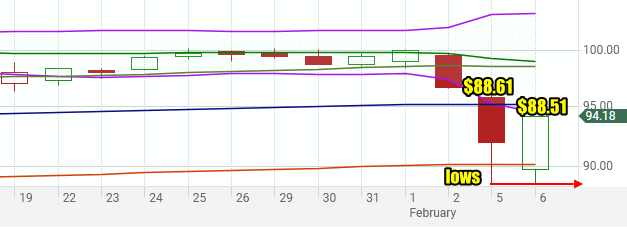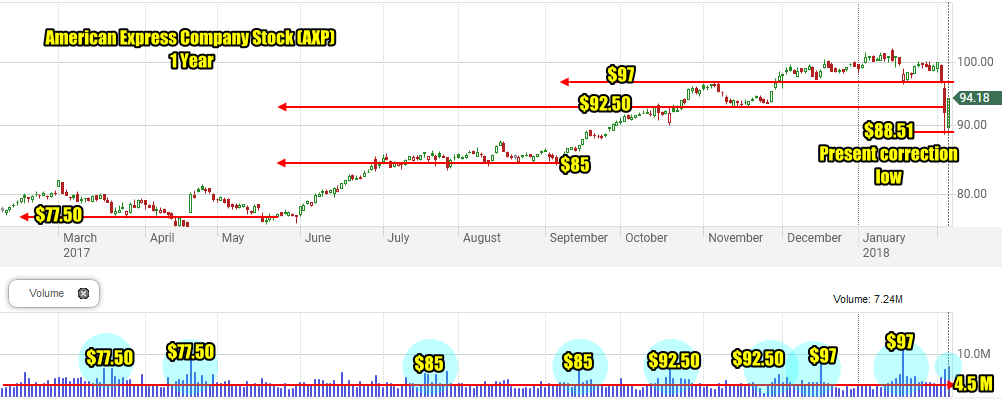
When selling put options for income, a market correction can become an excellent tool to use to better understand a stock that has been chosen for Put Selling.
It is also an excellent tool to use to understand rolling down existing short put options that might have been sold prior to the correction and which ended up in-the-money. Rather than accepting assignment of shares many investors will instead roll-down or roll out their position to earn more income as they try to avoid stock assignment until they have earned a large amount of income. A market correction can greatly assist in that rescue or repair effort as well.
A Market Correction And Selling Put Options
Aside from a rise in volatility that obviously increases put option premiums, a market correction offers clues to investors selling put options, as to what put strikes to consider selling during the correction itself. This means many times I am able to earn large than usual returns for selling a put option simply because all put options, including out of the money put options, gain more premium with the higher volatility a market correction generates.
Let’s take a look at American Express Company Stock (AXP) in the correction from February 2018 to understand how to use a market correction to assist Put Selling.
Example – American Express Company Stock (AXP)
Two charts are needed to be reviewed prior to selling put options during a correction. What we are looking for is those periods when the stock fell deeply but closed well off the low.
The first chart to review is the one month chart. In the downturn of Feb 5 and Feb 6, American Express Company Stock (AXP) fell to $88.61 on Feb 5 but closed at $92.01. The following day the stock fell to $88.51 but closed at $94.18.

American Express Company Stock (AXP) One Month Chart for Correction Feb 2018
Many investors would sell the $92.50 put strike after the stock jumped to $94.81 on the second day of a dip down to $88.51, and indeed in the correction was over and the stock was going to recover, then selling the $92.50 put strike would make sense. However in the midst of a correction, selling the $92.50 put strike could result in the put ending up in-the-money if the correction were to continue.
Instead the key would be to stay below the lows of $88.51 and selling the $87.50 or $87 put strike. This article was written on Feb 6. By the close on Feb 6, the $87.00 put strike for Feb 16 expiry, a week away was trading at 36 cents. This is a gain of 0.41% for a week and a half of risk. It is also below the lows the stock has put in.
For even more safety against the stock falling below your put strike if the correction were to continue, we turn to the 12 month chart.
AXP Stock 12 Month Chart
Looking at the 12 month chart we get a better idea of what put strikes to be selling. We need to add in the volume indicator and make sure the stock is set for daily.
You can see in the chart the present correction low of $88.51. For investors who would own shares if assigned, selling the $90 put strike does look tempting. Put premiums were also good on Friday at the close.
But for most investors who are selling options for income, we want to look at the volume indicator and draw a line that shows us the average daily volume. For American Express Company Stock (AXP), the daily average is 4.5 million shares traded. I then draw the line across the entire 12 month period and then look for periods when volume was ABOVE average. For periods I marked with blue circles. I then compare the periods of higher volume with the price in the stock chart. I then draw a line in the stock chart which matches the above average volume. This tells us which valuations a larger volume of investors are in the stock.

American Express Company Stock (AXP) 12 Month Daily Chart
If we look at the chart starting in January to February 2018 you can see that a fair number of investors were in the stock at $97 on average. That level broke down but it probably has a good chance of a rebound to that level if a second rally happen in the stock. However those who bought at $97 will probably want out of the stock if it bounces to $97. That means $97 may be tough for the stock to break through, at least for the next several weeks.
That tells us that call options above $97 are probably worth considering for selling especially in a second bounce. I would always use credit call spreads and make sure I was willing to turn the short call options into covered calls if I was wrong and the stock flew through $97. This is always the problem with selling call options in a correction. There can be big up days during corrections, just as there are big down days. So in a big up day the stock roars past $97 and I buy stock turning the short calls into covered calls only to find out a day or two later that the stock falls back down to $94 or lower, leaving me with out of the money covered calls and holding stock. That’s something I do not want, but I want to mention it for those investors who like to sell call options.
Selling Put Options
Knowing that $97 valuation is already broken by the correction, what I am looking for is a level in American Express Company Stock (AXP) where there was above average volume but which is below the $88.51 put strike. You can immediately see when we look at the chart for the year that $85 is the put strike to consider selling.
For March 16 expiry, the $85 put strike is 67 cents at the close on Tuesday. The Feb 23 expiry $85 put strike could probably earn 28 to 30 cents. This is not a huge gain but it has strength to withstand further selling if the correction continues. Normally I would sell 5 put options and then if the stock moves higher and I can close the trade for under 10 cents, I close the trade. If the stock instead falls lower, I look for the opportunity to add more short puts at $85.
A Market Correction And Rolling Down Put Options
The same charting methods can be used for rolling down put options. For example, if I sold the $85 put strike and the stock broke through $85 I know that there is more strength down at $77.50. Unless the correction is a recessionary collapse or a bear market, I know that the stock will recover in time. A drop of the stock below $85 means that I should work my way down to the $77.50 put strike. I can do this by first selling the $82.50 put strike and moving out by another month, which would be Apr 20 expiry and then if the stock continues lower and breaks $82.50 I would roll-down to $80 and into May and finally $77.50 and out to June.

American Express Company Stock (AXP) 12 Month Daily Chart
Example – Rolling Down In-The-Money Short Puts
How about using this method for an in-the-money put option. Perhaps before the correction started I had sold the $97.50 put strike for Feb 16 expiry. The rally on Tuesday would allow me to roll-down my position. The decision though is where to roll-down to.
During the day on Tuesday it would cost $6.35 to close the Feb 16 $97.50 put strike. If I wanted to have the safest roll-down with the best chance to not be assigned shares I would want to roll-down to below $88.51. I could consider $87.50 and realize that if the stock fell below it, I would have to roll-down to $85. However even if I go all the way out to April 20 expiry, the $87.50 put strike will only earn $2.65 during the day.
If I had sold 5 of the $97.50 and paid $6.35 to close I would spend $3175 to close this trade. This does not deduct the profit made when I originally sold the $97.50 put strike as I want to keep that profit. I do not want a break-even trade. I want a profitable trade. Therefore to roll-down to $87.50 For Apr 20 expiry I have to sell more naked puts. I would have to sell at least 12 naked puts for $2.65 to keep the trade profitable. 12 X $2.65 = $3180. This is not much profit considering I am going all the way out to April.
Better Choice
Instead a better choice would be to realize that the stock fell to $88.51 and that it could easily fall that low again, but commence a roll-down now and move from $97.50 to $92.50. For April 20 expiry the $92.50 put strike could be sold for $4.55. If I sold 8 put options I would make a profit moving from Feb to April. 8 X 4.55 = $3640.
Using the chart above I can see that if the stock falls to below $92.50 but stays above $88.50 I can probably hold the short puts into April by which time I would expect the stock to have recovered. The stock does not need to push higher above $92.50. It just needs to stay above $88.50.
By April 20 if the stock was at $90.00, I can buy back the $92.50 put strike and roll-down to the next put strike in the chart above with some strength and out to June 15 expiry. That would be the $85 put strike. If it required too many short put options to be sold for that large a roll-down I could move to the $87.50 put strike and then if by June the stock was below $87.50, then roll-down to $85.
Less Attractive But Definitely Interesting – The Jan 2019 Leap
Another choice, especially if the investor liked the stock would be to include a few leap puts.
For example it will cost $6.35 per put contract to buy to close the $97.50 put strike for Feb 16 expiry. During the afternoon, the $95 put strike was $10.75 for Jan 18 2019 expiry. The total cost to close the trade was $6.35 X 5 = $3175.00 . I could sell 2 of the $95 put strike for a total of $2150 and then sell the $87.50 put strike. I could then sell 3 of the $92.50 put strike for April 20 expiry for $4.55 which would earn $1365. This keeps the trade at 5 put options only, the same as the original, but is lower in put strikes sold and earns $3515.
Other Choices
All the above trades rely on the stock chart and understanding the lows of the correction to determine the likelihood of the stock falling much below those correction lows. But even if the correction were to deepen, the above table shows us that there is buying interest at $88.50 and by following the chart levels, I could keep rolling positions that end up in-the-money, probably almost indefinitely until the correction ends. This method was a principal method used in the bear market of 2007 to 2009.
There are of course other choices including deciding whether to remain in American Express Company Stock (AXP) at all. If owning shares should I be assigned, no longer interest me or if I become concerned about the stock, I would normally close the trade and recover the loss in a different stock. There is no rule that advises us that we must stay with the stock to repair the trade. Sometimes the stock is just not the best for trading as events change. When that happens, it is time to recover the loss through another stock but I always use the same method as above, for the new stock picked.
Disclaimer: There are risks involved in all investment strategies and investors can and do lose capital. Trade at your own risk. Stocks, options and investing are risky and can result in considerable losses. None of the strategies, stocks or information discussed and presented are financial or trading advice or recommendations. Everything presented and discussed are the author’s own trade ideas and opinions which the author may or may not enter into. The author assumes no liability for topics, ideas, errors, omissions, content and external links and trades done or not done. The author may or may not enter the trades mentioned. Some positions in mentioned stocks may already be held or are being adjusted.
